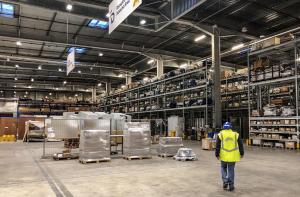An elbow joint's odyssey
A journey through the ITER warehouse system.
Walking among the spartan aisles and towering shelves of the massive ITER warehouse is like walking through the self-serve area at the back of an IKEA store. But instead of bookcases and bed frames, this warehouse is home to parts for the world's largest nuclear fusion facility, from multi-tonne tokamak components to tiny pieces of hardware smaller than walnuts. Like the 90° elbow joint that Daniel Mittag has just plucked from a box on shelf 31-B-03-C.
"We need to track it and preserve it just like everything else," says Daniel. "This joint has been custom designed, you can't run down the street and buy this at the hardware store, so if it goes missing, we are talking big delays for the project."
The ITER warehouse system is overseen by the Construction Management Office (CMO), which provides transversal support for the construction and logistics activities on the worksite. ITER's global logistics service provider Daher is in charge of warehouse services, however as the leader of the CMO's Integrated Material & Logistics Management Group Daniel is ultimately responsible for the 1.5 million components currently being stored in the system.
"I started working in logistics when I was unloading boxes in a warehouse as a high school job and I've been doing it ever since," says Daniel, who is now two decades into this career. "This is the most challenging mission I've had because the project is so complex and we need to give everybody at ITER 100% service, whether for a first-of-kind component like a vacuum vessel sector or something like this elbow joint."
The elbow joint in question began its journey to the ITER warehouse about five years ago when it was a mere digital concept in a 3D drawing. One of ITER's missions is to test the generation of tritium needed for high-performance nuclear fusion reactions. Jamal Ait El Mousse is one of the ITER engineers who has worked on the tritium breeding system, including the tritium extraction system (for processing) and the tritium accountancy system. These tritium subsystems have to fit into a tight space in the machine without interfering with other infrastructure, so the routing system required lots of twists and turns—hence Jamal needed the 90° elbow joints.
The joints had to meet nuclear pressure equipment regulation (ESPN) and nuclear safety standards (ASN) in France while also being standard-size so they could be made on conventional machines. The design was done with the help of a Spanish subcontractor and then, once it was approved in late 2019, 22 elbow joints were added to a larger purchase order that was sent onto one of the ITER suppliers, W. Schulz (Germany).
From pipe material sourced in China, Schulz cut and machined the elbow joints to ITER standards. In December 2020, the finished joints were inspected by Schulz quality control officers as well as an independent inspector hired by the ITER Organization. Once cleared, they were added to Packing List PL0121177, combined with other orders, and entrusted to the transporter AStrans for the 1,100-kilometre trip to ITER.
"It's an amazing logistics process," says Jamal. "It's a little component but its journey shows the global cooperation that is behind ITER."
Storage was another puzzle to solve. ITER has a main 36,000m² warehouse on the northern edge of its site in Saint-Paul-lez-Durance and five 6,000m² storage facilities near the port in Fos-sur-Mer. An item's initial location depends on available space and storage requirements (D for outdoors, C for indoors, B for temperature control, and A for humidity and temperature control). Because of its radioactive confinement role in the tritium system, the elbow joint was classified as a Protection Important Component (PIC) and given a C classification for the main warehouse, so this is where it was delivered by AStrans.
On average, four or five shipments arrive at the main warehouse each day. Once the box with the elbow joint was unloaded, Daher warehouse personnel carried out a Level 3 inspection, checking for quantity, cleanliness, and damage. (There are four types of inspections, from Level 1, where each component needs meticulous inspection, to Level 4 where only the main box is inspected for transit damage.) Then, the storage process could begin.
The elbow joint had been logged into ITER's SmartPlant® storage database before it arrived as expected material; now, the software assigned it to a shelf based on its weight and available space and issued a label. The preservation code on the label called for the elbow joint to be checked every six months; as a result, it has undergone two additional warehouse inspections since arriving at ITER.
The elbow joint will be used sometime after June 2022 when the piping system is assembled in the Tokamak Building. It is already part of Hand-Over-Package 1266, but there are more steps before the elbow joint has its moment in the sun. Other documents need to be generated so that assembly instructions are ready at the same time as the part (such as engineering and construction work packages). Then, after final ITER approval, a Material Issuing Report will be printed and later this year, a contractor will receive the elbow joint along with the other components needed to assemble the tritium piping system.
It's unlikely that anybody from the design or warehouse team will ever see the elbow joint after its installation, but that doesn't diminish the sense of satisfaction. "There are many logistics managers doing something important," says Daniel, "but what we are doing in our ITER warehouse is important for the whole world."



